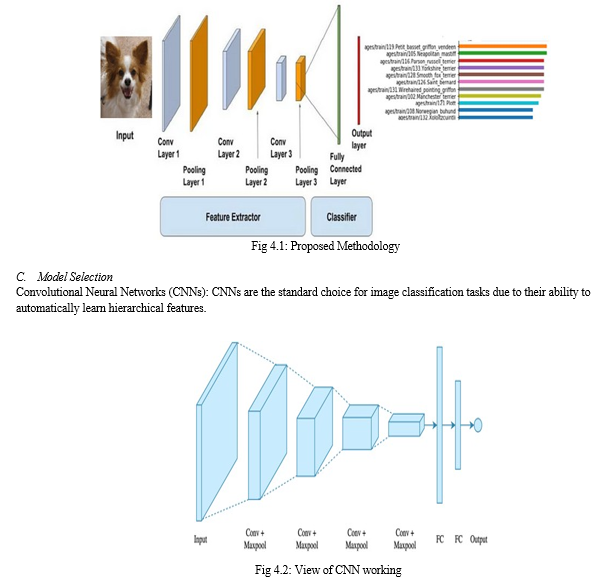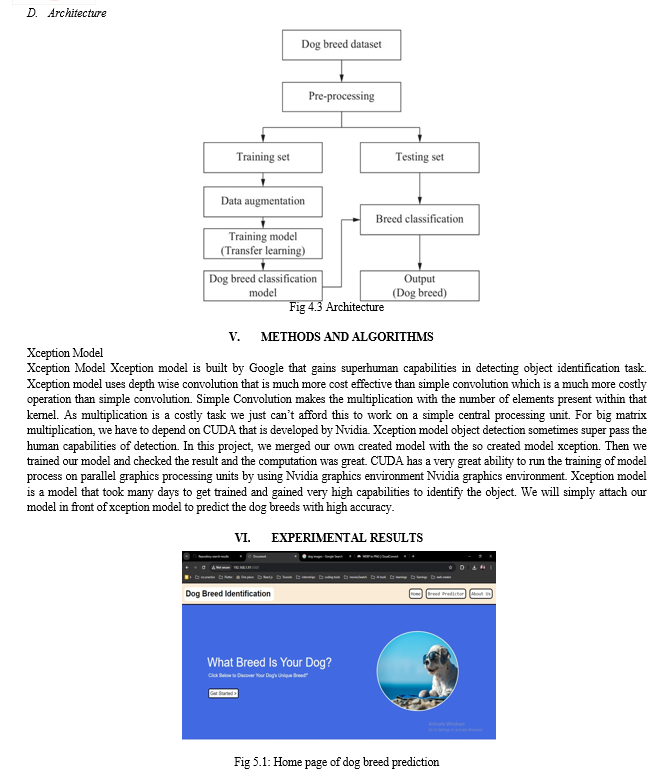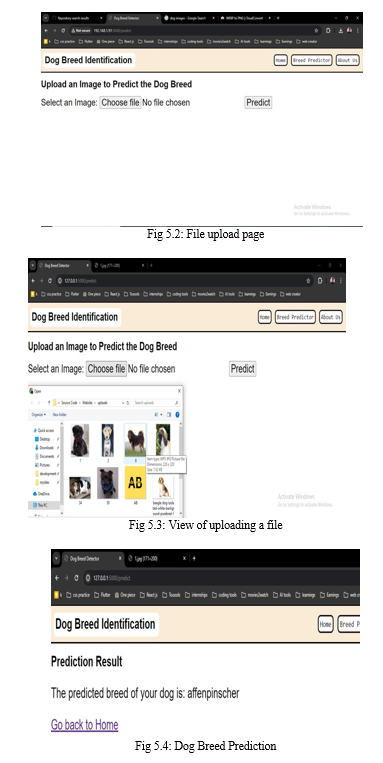Ijraset Journal For Research in Applied Science and Engineering Technology
- Home / Ijraset
- On This Page
- Abstract
- Introduction
- Conclusion
- References
- Copyright
Dog’s Breed Prediction using Deep Learning
Authors: K. Jagadesh , P. Kavya , A. Lavanya , A. LaxmiPriya, B. Harshini , Dr. Gifta Jerith
DOI Link: https://doi.org/10.22214/ijraset.2024.61626
Certificate: View Certificate
Abstract
Dog Breed Prediction from Images using Deep Learning, in this project, we propose a Convolutional Neural Network (CNN) based approach for predicting dog breeds from images. With the increasing popularity of dogs as pets and the need for proper care and maintenance, it is essential to identify the breed of a dog accurately. However, manual identification can be time-consuming and prone to errors. Therefore, we propose a deep learning-based solution that can predict the breed of a dog with high accuracy. We train a CNN model on a large dataset of dog images, where each image is labeled with the breed of the dog. The model learns to extract features from the images and classify them into one of the 180 breeds. We evaluate the performance of the model using standard metrics and compare it with other machine learning algorithms. Our experimental results show that the proposed CNN model outperforms other algorithms in predicting dog breeds from images. The model achieves an accuracy of 90%, making it a reliable tool for dog breed prediction. Additionally, we develop a web application that allows users to upload an image of a dog and predict its breed using our model. This project demonstrates the effectiveness of deep learning techniques in predicting dog breeds from images. The proposed CNN model can be a valuable tool for veterinarians, pet owners, and breeders, helping them identify the breed of a dog accurately and efficiently.
Introduction
I. INTRODUCTION
The objective of this project is to develop a robust deep learning model capable of accurately identifying the breed of a dog from an input image. Such a model holds immense potential for a wide array of applications, including veterinary medicine, pet adoption services, and even law enforcement agencies working with K-9 units. By leveraging state-of-the-art deep learning techniques, this project aims to push the boundaries of dog breed classification accuracy while also exploring the underlying mechanisms of feature extraction and representation learning within CNN architectures. The ability to accurately identify dog breeds is crucial in various applications, including veterinary care, pet ownership, and breeding. With over 180 recognized dog breeds, each with unique characteristics and traits, manual identification can be time- consuming and prone to errors. Recent advancements in deep learning have enabled the development of computer vision models that can classify images with high accuracy. In this project, we leverage these advancements to develop a deep learning-based approach for predicting dog breeds from images. By training a convolutional neural network (CNN) on a large dataset of dog images, we aim to create a model that can accurately classify a given image into one of the 5 breeds present in our dataset. This project has the potential to provide a reliable and efficient tool for dog breed identification, with applications in various fields.
II. PROBLEM STATEMENT
The aim is to develop dog breed recognization using deep learning(CNN) that usesinformation of the dog breed images to give higher exactness over past researches. The complexity of identifying diverse dog breeds from images presents a significant challenge, especially with traditional methods proving inadequate for precise classification. Current approaches lack adaptability to accurately discern between various dog breeds, demanding an advanced automated solution. This study aims to bridge this gap by developing a reliable deep learning-based system capable of accurately predicting and categorizing diverse dog breeds from images, thereby enhancing accuracy in breed classification and facilitating applications in fields like veterinary care and pet welfare.The proposed deep learning model will leverage Convolutional Neural Networks (CNNs), a state-of-the-art technique in image recognition, to effectively capture intricate patterns and features unique to different dog breeds. By training the model on a vast dataset comprising images of various dog breeds, it will learn to discern subtle differences in morphology, coat texture, coloration, and other distinguishing characteristics specific to each breed.
III. LITERATURE REVIEW
In this research [1], to categorize and identify pet dogs’ faces, the researchers offered an improved Yolov3 model. Eight distinct breeds of pet dogs were used to construct the dataset for this study. The data set was split into two categories: training and testing, with the training set being used to train the established model. Using more widespread pet dogs as samples, it was suggested by the authors a yolov3-based pet dog categorization model.
Instead of using the pet dog’s general characteristics, the model chose the face of the pet dog and marked the dog category by detecting facial features, similar to face detection. The trials’ findings demonstrated that this approach was capable of rapidly and correctly locat- ing the position of a pet dog’s face, and it resolved the issue of pet dog detection and categorization.
In this paper [2], the authors studied how animal identifi- cation in veterinary practice was managed through machine learning. Electronic animal health records included digi-tal image graphs using image processing and recognition technology to identify animals. The authors studied how combining ‘‘soft’’ biometrics, such as breed and facial bio- metrics, could improve dog identification. The researchers applied transfer learning from GoogLeNet to propose Breed- Net for breed classification and subsequently to propose DogNet for identifying individual dogs within the classified breeds.
In this article [3], by determining a dog’s breed in a given image, this work aimed to solve the problem of fine-grain and multi-class image recognition. One of the sophisticated deep learning approaches used in the research system was convo-lutional neural networks. Two distinct networks were con-structed and assessed using the Stanford Dogs dataset. Con-volutive neural networks’ application and evaluation were demonstrated using a software system. It had a central server and a mobile client with resources and tools for online and offline neural network analysis. Two distinct convolutional neural network architectures were presented: the Inception-ResNet-v2 deep architecture and the NASNet- A mobile architecture. Deep Inception-ResNet-v2 model outperformed even the smaller, mobile-friendly CNN, with results that were still encouraging.
This study [4] provided two models for categorizing dogs into different breeds. Due to the increasing difficulty of clas- sifying dogs and the fact that these classifications were based on deep learning, forming the two models that provide differ- ent levels of accuracy at both ends requires a fully defined data set. Since every model was periodically subjected to predictions, the researchers encountered numerous function- ing levels during the investigation that weren’t considered in earlier research. The essential concept of transfer learning, which dealt with the data augmentation technique and its capacity to increase the size of the data set, is also built upon by their approach. Afterward, accuracy levels were matched or compared with both models to establish a comparison for both models. A detailed procedure was also used to classify the data. The comparison between Inception V3 and VGG16 was offered in the publication. Observations showed that Inception V3 offered an accuracy of 85, whereas VGG16 provided a much lower accuracy of 69 than the Inception V3 model.
In this article [5], deep learning made it possible to train algorithms (models) that could categorize and forecast data based on the knowledge that was extracted (learned) from the raw data. Convolutional Neural Networks were one method that was commonly employed for image categoriza-tion and detection. In this research, the authors discussed dog breed/type identification after providing a CNN-based method for dog detection in potentially complex images. The findings had a 64% accuracy rate for 120 additional, less common dog varieties and a breed classification accuracy of about 85% for a group of 50 dog breeds. A big data processing infrastructure using a variety of GPUs and an iOS application supporting image classification techniques were used. To enhance the integrity of the data, several preparation methods were employed.In this study [6], there were many different species and organisms in the world today. This highlights how important it was to classify different tangible objects. Determining the similarities between distinct classes also became extremely important in light of the continuing genetics and evolution study being conducted by scientists worldwide. The exper-iment that provided the basis for this essay involved classi-fying different canine breeds using a CNN (Convolutional Neural Network). This algorithm will identify an estimated breed if a canine image is found. The type of dog that most closely resembled a human, if one was given, was identified. The authors created a pipeline to handle photos from the actual world. The dog breed classifier did an excellent job, with extremely good accuracy.In this article [7], the researchers used cutting-edge models on Imagenet data sets. To extract the feature from the data set used to identify dog breeds, the pre-trained model and learned weights were used. After that, data augmentation and fine-tuning were used to improve the performance of their test’s breed categorization accuracy. The performance of the proposed methods was compared with the GoogleNet, DenseNet-169, DenseNet-121, and ResNet-50 models from the most current Image-Net dataset. Their respective test accuracies were 82.08%, 84.01%, 85.37%, and 89.66%, demonstrating the proposed method’s superior performance to earlier efforts on Stanford dog breed datasets.
IV. METHODOLOGY
A. Existing System
ResNet-50 for Dog Breed Prediction
This system uses a pre-trained ResNet-50 model to predict the breed of a dog. The model is fine-tuned on a dataset of dog images and breed labels.
- DogNet: A Deep Neural Network for Dog Breed Classification This system uses a custom-designed deep neural network called DogNet to predict the breed of a dog. DogNet is designed to be more effective at recognizing dog breeds than other pre-trained models.
- DeepBreed: A Deep Learning System for Dog Breed Prediction This system uses a deep convolutional neural network to predict the breed of a dog. It was trained on a large dataset of dog images and breed labels.
B. Proposed System
IThe proposed system utilizes a deep Convolutional Neural Network, specifically the Xception architecture, to classify and learn the breed's characteristics. The proposed system can handle large-scale classification tasks, making it suitable for predicting the breed of dogs from a large dataset. The Xception architecture used in the system is efficient and has been shown to perform well in image classification tasks. The system has real-world applications, such as in veterinary medicine, animal shelters, pet-related industries, where identifying the breed of a dog can be useful.



VII. ACKNOWLEDGEMENT
I would like to express my heartfelt gratitude to my guide Dr.Gifta Jerith and head of department, Dr .Thayyaba Khatoon, for their invaluable guidance and unwavering support throughout the development of this project. Their insightful feedback helped me to refine my ideas and develop a comprehensive understanding of the subject matter. Their mentorship was instrumental in shaping my approach towards the project, and I am grateful for the knowledge and experience they shared with me. Without their encouragement and support, this project would not have been possible. Once again, I extend my sincere thanks to my guides and head of department for their unwavering support and guidance. Our sincere thanks to all the teaching and non-teaching staff of Department of Computer Science and Engineering (AI&ML) for their support throughout our project work.
Conclusion
In conclusion, our CNN-based face mask detection system demonstrates promising results in accurately identifying individuals wearing masks in various settings. Through rigorous training and optimization, we achieved a commendable level of accuracy. However, challenges such as variations in lighting, angles, and diverse facial features remain areas for improvement. Despite these challenges, the potential applications of this technology in public health, security, and workplace safety are vast, offering opportunities for real-world deployment and societal impact.\"
References
[1] D. M. Sundaram and A. Loganathan, ‘‘A new supervised clustering framework using multi discriminative parts and expectation–maximization approach for a fine-grained animal breed classification (SC-MPEM),’’ Neural Process. Lett., vol. 52, no. 1, pp. 727–766, Aug. 2020. [2] G. Kanika, G. Sharankhala, A. Bhavya, and G. Riya, ‘‘Dog breed iden-tification using CNN architecture,’’ Int. J. Sci. Eng. Res., vol. 11, no. 6, pp. 1040–1045, 2020. [3] I. Sneha, ‘‘Dog breed prediction using convolutional,’’ Neural Netw. Int. J. Eng. Adv. Technol., vol. 9, no. 5, pp. 318– 322, Jun. 2020. [4] T. Sadanandana, ‘‘Dog breed identification using pre- trained models,’’ International Journal of Computer Science and Mobile Computing, vol. 9, no. 4, pp. 76–82, 2020. [5] Z. Wang, D. Zhao, and K. Hong, Dog Breed Classification. San Diego, CA, USA: ECE Project Univ. California, 2020. [6] P. Borwarnginn, W. Kusakunniran, S. Karnjanapreechakorn, and K. Thongkanchorn, ‘‘Knowing your dog breed: Identifying a dog breed with deep learning,’’ Int. J. Autom. Comput., vol. 18, no. 1, pp. 45–54, Feb. 2021, doi: 10.1007/s11633-020-1261-0. [7] B. K. Shah, A. Kumar, and A. Kumar, ‘‘Dog breed classifier for facial recognition using convolutional neural networks,’’ in Proc. 3rd Int. Conf. Intell. Sustain. Syst. (ICISS), Dec. 2020, pp. 508–513, doi: 10.1109/ICISS49785.2020.9315871. [8] D. Hsu, Using Convolutional Neural Networks to Classify Dog Breeds, document CS231n, Convolutional Neural Networks for Visual Recogni-tion, Feb. 2015. [9] X. S. Higa, ‘‘Dog breed classification using convolutional neural networks: Interpreted through a lockean perspective,’’ Senior Theses Student Publication, 2019. [Online]. Available: https://core. ac.uk/download/pdf/214315107.pdf [10] S. Kearney, W. Li, M. Parsons, K. I. Kim, and D. Cosker, ‘‘RGBD-dog: Predicting canine pose from RGBD sensors,’’ in Proc. IEEE/CVF Conf. Comput. Vis. Pattern Recognit. (CVPR), Jun. 2020, pp. 8333–8342, doi: 10.1109/ cvpr42600.2020.00836. [11] A. K. Agarwal, V. Kiran, R. K. Jindal, D. Chaudhary, and R. G. Tiwari, ‘‘Optimized transfer learning for dog breed classification,’’ Int. J. Intell. Syst. Appl. Eng., vol. 10, no. 1s, pp. 18–22, Oct. 2022. [12] N. H. Pratama, E. Rachmawati, and G. Kosala, ‘‘Classification of dog breeds from sporting groups using convolutional neural network,’’ JIPI (Jurnal Ilmiah Penelitian Dan Pembelajaran Informatika), vol. 7, no. 4, pp. 1080–1087, Nov. 2022. [13] S. Ramaneswaran, K. Srinivasan, P. M. D. R. Vincent, and C.-Y. Chang, ‘‘Hybrid inception v3 XGBoost model for acute lymphoblastic leukemia classification,’’ Comput. Math. Metho.
Copyright
Copyright © 2024 K. Jagadesh , P. Kavya , A. Lavanya , A. LaxmiPriya, B. Harshini , Dr. Gifta Jerith. This is an open access article distributed under the Creative Commons Attribution License, which permits unrestricted use, distribution, and reproduction in any medium, provided the original work is properly cited.

Download Paper
Paper Id : IJRASET61626
Publish Date : 2024-05-05
ISSN : 2321-9653
Publisher Name : IJRASET
DOI Link : Click Here
 Submit Paper Online
Submit Paper Online

